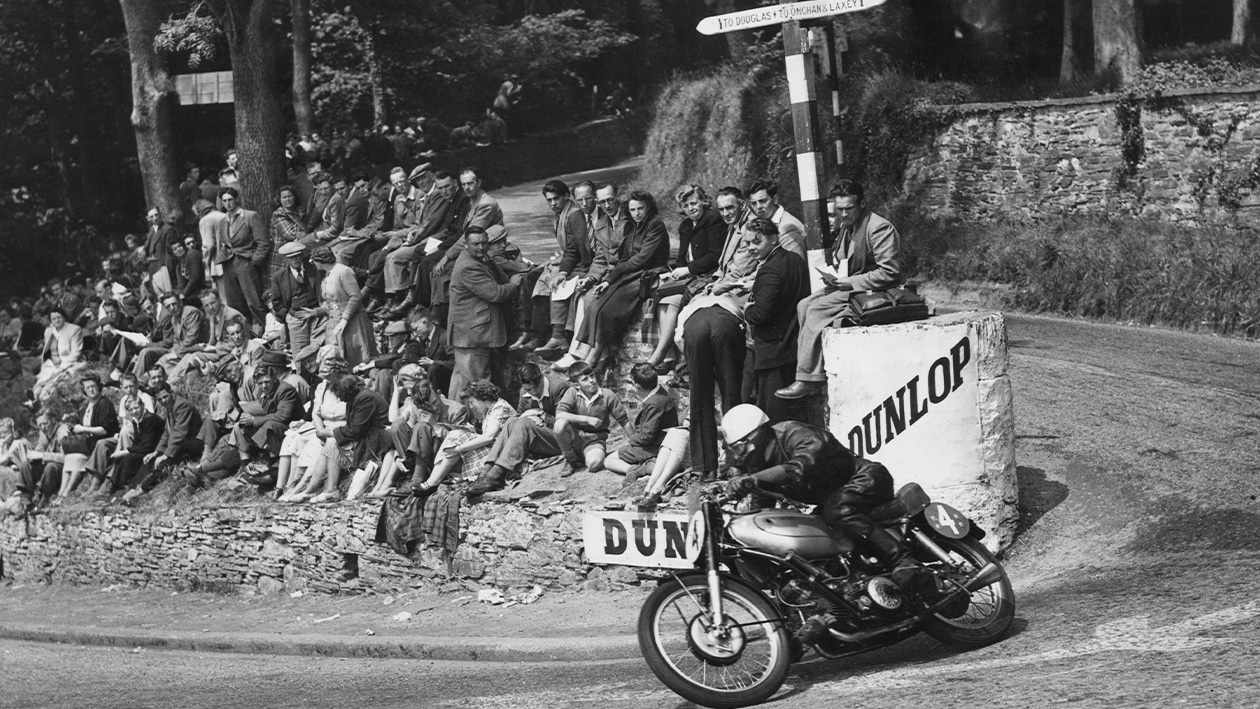Mat Oxley: On MotoGP’s 75th anniversary, it’s time to look at the first title-winning bike‚ the ‘Porc’
AJS E90 ‘Porcupine’ was ridden to 1949 World Motorcycle Championship glory by Les Graham

Les Graham rides a Porcupine in the 1950 Isle of Man Senior TT
Getty Images
MotoGP celebrates its 75th anniversary this year, so now is the right time to look at the strange motorcycle – nicknamed the ‘Porcupine’, or the ‘Porc’ for short – that won the inaugural 1949 world championship.
Unlike most British racing motorcycles the AJS E90 wasn’t created in Britain’s industrial heartlands – the Norton and BSA factories were in Birmingham, Triumph in nearby Meriden – it was built in Plumstead, south-east London.
In fact AJS (named after Albert John Stevens, one of four brothers who were tinkering with engines from the 1890s) had started life in Wolverhampton but got into trouble when it expanded into the car and bus business. In 1931 the AJS motorcycle division was bought by Plumstead-based Matchless, owned by the famous Collier brothers – Charlie Collier had won a race in the original 1907 Isle of Man TT.
In other words, history runs deep in the Porc. Its story goes back to the late 1930s, when BMW’s supercharged boxer twin and Gilera’s supercharged four ruled the 500cc European championship, the precursor of the MotoGP world championship. AJS engineers were obsessed with beating their European rivals, so they designed a supercharged V4, which was hugely powerful but handled terribly. At the 1939 Ulster Grand Prix the V4 became the first motorcycle to lap the viciously bumpy Clady street circuit at 100mph, shortly before snapping its front suspension.
AJS engineers decided a lighter, neater supercharged twin would be a better all-round machine, so they went back to their drawing board. And then World War II started.
When racing resumed in Europe there was bad news for AJS. Times were hard and the only petrol available was “little better than paraffin” (according to one engineer), so supercharging was banned. AJS should have scrapped the supercharged engine and restarted from scratch, but management didn’t want to spend the money, so engineers were tasked with transforming a low-revving, low-compression supercharged engine into a high-revving, high-compression naturally aspirated engine. The Porc was compromised.
Why the Porc? Supercharged engines make a lot of power and a lot of heat. The E90 was air-cooled – to save weight – so its designers had to find other ways to cool the engine. They arranged the parallel twin’s cylinders horizontally, in the cooling breeze, and covered the cylinder head in spikes, instead of fins, to improve airflow. Hence Porcupine.
The first naturally aspirated Porc was a joke. On the dyno in Plumstead it puffed out a weedy 29hp, considerably less than Norton’s single-cylinder MotoGP bike, based on an ancient 1920s design.
“On the eve of the 1949 season they had 49hp. Just enough”
AJS engineers did their best to turn a sow’s ear into a purse. They made a new cylinder head to raise compression and a heavier crankshaft to suit the lower inertia of a normally aspirated engine, but the Porcupine was still handicapped by long induction tracts, originally included to damp down the pressure fluctuations inherent in a blown engine. Carburation was thus a neverending nightmare. Bit by bit they squeezed more performance out of the engine, until – on the eve of the 1949 season – they had 49hp. Just about enough. As mentioned, with more power comes more heat. And so much heat that engineers wanted to cast the Porc’s cylinder head in silver, for maximum heat dissipation. AJS’s accountants weren’t so keen.
The best thing about the Porc was its rider – decorated WWII bomber pilot Les Graham, who proved his man/machine interaction abilities during a raid on the Nazi U-boat pens in Bordeaux. Graham was at the controls when a Lancaster flying beneath his own Lanc blew up. The blast flipped Graham’s plane onto its back, dumping him out of the pilot’s seat.
“All of a sudden we were hurtling towards the ground,” recalled Graham’s navigator Bill Bissonnette. “As we flipped, Les spilled into the centre of the craft and I thought our end had come. Les was scrambling about, draped over the throttles and trying to reach the stick. Finally he got his left hand on it and managed somehow to pull us out of it.” This deed won Graham the Distinguished Flying Cross.
When the first MotoGP championship got underway on the Isle of Man in June 1949, Graham ran away with the race until a magneto shaft sheared with just two miles remaining. A fortnight later he won the Swiss GP at Bern and the following month the Ulster GP at Clady, just enough to take the first MotoGP crown by a single point from Gilera’s Nello Pagani.
The story might have been different if Gilera had contested the TT, but the team balked at the 1200-mile trip from Milan to the Isle of Man.
The following year the Porc was bettered by both Gilera and Norton, so Graham defected to MV Agusta. He’d had enough of AJS penny-pinching.
The usually autocratic Count Domenico Agusta was so impressed by Graham’s technical know-how that he gave him a largely free hand in development. At Monza in 1952 Graham took MV’s first premier-class MotoGP win, making the Anglo-Italian marriage favourite for the 1953 world title. Sadly, it was not to be. Graham crashed during the Senior TT when the MV’s experimental Earles suspension jammed as he rode through the Bray Hill dip at full speed. He was killed instantly.
Mat Oxley has covered motorcycle racing for many years – and also has the distinction of being an Isle of Man TT winner
Follow Mat on Twitter @matoxley

